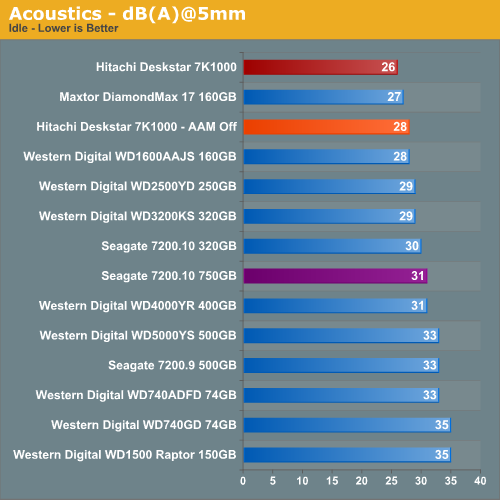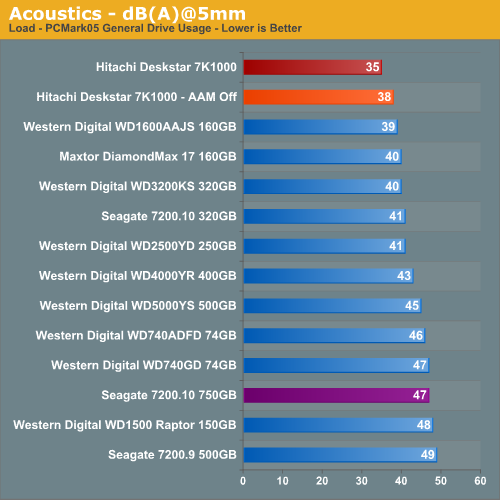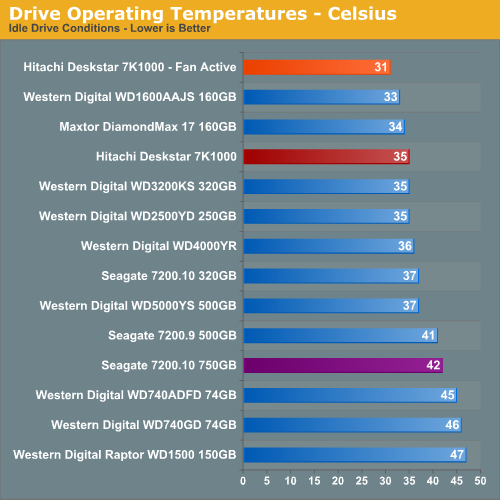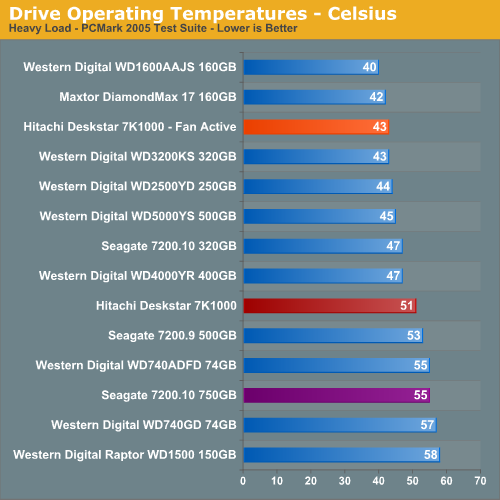Hitachi Deskstar 7K1000: Terabyte Storage arrives on the Desktop
by Gary Key on March 19, 2007 8:00 AM EST- Posted in
- Storage
Hard Drive Performance: Acoustics
Our acoustic test utilizes our standard test bed components but we implement AMD's Cool'n'Quiet technology and turn off the case fans to isolate as much case noise as possible during testing. Our OCZ power supply is nearly silent in these tests and our fanless ASUS 7600GS video card provides a further decrease in our case's ambient noise levels. Our drives are attached to the drive cage with rubber bushings to assist in isolating the noise of the drive without resulting harmonic changes due to the case design
Our acoustic tests are designed to measure the decibel levels while the system is at idle and also under load while running the General Hard Disk Drive Usage benchmark within PCMark 2005. We found through trail and error that this particular benchmark produces controlled readings across a wide range of applications within the benchmark. This particular benchmark utilizes 60% reads and 40% writes within the trace playback file.
The measurements are taken at a distance of 5 millimeters from the rear and front of the drive being tested in order to minimize surrounding environmental noise. We take our measurements over a period of twenty minutes, so idle measurements will include operating system interrupt and polling routines. We have noticed that unless we run a silent system in a near silent room that measurements taken from 1 meter are generally not meaningful due to ambient noise levels. There are exceptions like the Raptor series of drives but overall most modern desktop drives are quieter now than the other components in the system.
The reported measurements are based on an A-weighted decibel score that measures frequencies similar to the way the human ear responds to sound. We take a total of three measurements for each test. We then subtract the high and low scores and arrive at our findings by reporting the remaining score.


Our Hitachi Deskstar 7K1000 is the quietest drive that we have ever tested. We basically could not hear the drive and at times wondered if it was operating with AAM turned on. Even with AAM turned off, the drive was extremely quiet at idle and under load where it still scored better than our other test units. Our subjective opinion with AAM turned off is that the seek requests are muted greatly but still noticeable when compared to the other drives. The only other significant audible noise is a slight whirling sound as the drive spins up on a cold start or after a reboot. We just cannot emphasize enough how quiet this drive is in our test configuration with AAM enabled at the 128 setting. We even removed the rubber mounting grommets in our drive cage and did not notice any differences in acoustics or vibration levels. Our base dB(A) level in the room at time of testing was 25 dB(A).
Hard Drive Performance: Thermals
Our thermal tests utilize sensor readings via the S.M.A.R.T. (Self-Monitoring, Analysis and Reporting Technology) capability of the drives and are reported by utilizing the Active SMART 2.42 utility. We test our drives in an enclosed case environment without the front fan operational to simulate temperatures that could conceivably be reached in a SFF or HTPC case design. We typically find the reported numbers drop anywhere from 18% to 25% on average when the front fan is operational.
We typically let the drive idle for fifteen minutes before starting our idle thermal testing. Our load testing consists of taking the high temperature reading after looping the PCMark 2005 HD Suite benchmark five times. We also check load temps after looping our Nero Recode encoding test three times.


We expected the 7K1000 to run as warm as the Seagate 750GB due to the five platter design. However, under both idle and load conditions it operated significantly cooler than Seagate's large capacity PMR design. We have additional power and thermal management tests to run but at this time we were pleasantly surprised with the results. The load temperatures dropped from 51C to 43C and idle temps dropped from 35C to 31C with our front case fan operational. We highly recommend a fan be installed near the drive during normal operation. Our test room temperatures were 24C during these tests.
Our acoustic test utilizes our standard test bed components but we implement AMD's Cool'n'Quiet technology and turn off the case fans to isolate as much case noise as possible during testing. Our OCZ power supply is nearly silent in these tests and our fanless ASUS 7600GS video card provides a further decrease in our case's ambient noise levels. Our drives are attached to the drive cage with rubber bushings to assist in isolating the noise of the drive without resulting harmonic changes due to the case design
Our acoustic tests are designed to measure the decibel levels while the system is at idle and also under load while running the General Hard Disk Drive Usage benchmark within PCMark 2005. We found through trail and error that this particular benchmark produces controlled readings across a wide range of applications within the benchmark. This particular benchmark utilizes 60% reads and 40% writes within the trace playback file.
The measurements are taken at a distance of 5 millimeters from the rear and front of the drive being tested in order to minimize surrounding environmental noise. We take our measurements over a period of twenty minutes, so idle measurements will include operating system interrupt and polling routines. We have noticed that unless we run a silent system in a near silent room that measurements taken from 1 meter are generally not meaningful due to ambient noise levels. There are exceptions like the Raptor series of drives but overall most modern desktop drives are quieter now than the other components in the system.
The reported measurements are based on an A-weighted decibel score that measures frequencies similar to the way the human ear responds to sound. We take a total of three measurements for each test. We then subtract the high and low scores and arrive at our findings by reporting the remaining score.


Our Hitachi Deskstar 7K1000 is the quietest drive that we have ever tested. We basically could not hear the drive and at times wondered if it was operating with AAM turned on. Even with AAM turned off, the drive was extremely quiet at idle and under load where it still scored better than our other test units. Our subjective opinion with AAM turned off is that the seek requests are muted greatly but still noticeable when compared to the other drives. The only other significant audible noise is a slight whirling sound as the drive spins up on a cold start or after a reboot. We just cannot emphasize enough how quiet this drive is in our test configuration with AAM enabled at the 128 setting. We even removed the rubber mounting grommets in our drive cage and did not notice any differences in acoustics or vibration levels. Our base dB(A) level in the room at time of testing was 25 dB(A).
Hard Drive Performance: Thermals
Our thermal tests utilize sensor readings via the S.M.A.R.T. (Self-Monitoring, Analysis and Reporting Technology) capability of the drives and are reported by utilizing the Active SMART 2.42 utility. We test our drives in an enclosed case environment without the front fan operational to simulate temperatures that could conceivably be reached in a SFF or HTPC case design. We typically find the reported numbers drop anywhere from 18% to 25% on average when the front fan is operational.
We typically let the drive idle for fifteen minutes before starting our idle thermal testing. Our load testing consists of taking the high temperature reading after looping the PCMark 2005 HD Suite benchmark five times. We also check load temps after looping our Nero Recode encoding test three times.


We expected the 7K1000 to run as warm as the Seagate 750GB due to the five platter design. However, under both idle and load conditions it operated significantly cooler than Seagate's large capacity PMR design. We have additional power and thermal management tests to run but at this time we were pleasantly surprised with the results. The load temperatures dropped from 51C to 43C and idle temps dropped from 35C to 31C with our front case fan operational. We highly recommend a fan be installed near the drive during normal operation. Our test room temperatures were 24C during these tests.










74 Comments
View All Comments
Gary Key - Monday, March 19, 2007 - link
It has worked well for us to date. We also took readings with several other programs and a thermal probe. All readings were similar so we trust it at this time. I understand your concern as the sensors have not always been accurate.mkruer - Monday, March 19, 2007 - link
I hate this decimal Byte rating they use. They say the capacity is 1 TeraByte meaning 1,000,000,000,000 Bytes, this actually translates into ~930GB or .93TB that the OS will see using the more commonly used (base 2) metric. This is the metric that people assume you are talking about. When will the drive manufactures get with the picture and list the standard Byte capacity?Spoelie - Tuesday, March 20, 2007 - link
I don't think it matters all that much, once you heard it you know it. There's not even a competitive marketing advantage or any scamming going on since ALL the drive manufacturers use it and in marketing material there's always a note somewhere explaining 1GB = blablabla bytes. So 160GB on one drive = 160GB on another drive. That it's not the formatted capacity has been made clear for years now, so I think most people who it matters for know.Zoomer - Wednesday, March 21, 2007 - link
IBM used to not do this. Their advertised 120GB drive was actually 123.xxGB, where the GB referred to the decimal giga. This made useable capacity a little over 120GB. :)JarredWalton - Monday, March 19, 2007 - link
See above, as well as http://en.wikipedia.org/wiki/SI_prefix">SI prefix overview and http://en.wikipedia.org/wiki/Binary_prefix">binary prefix overview for details. It's telling that this came into being in 1998, at which time there was a class action lawsuit occurring I believe.Of course, you can blame the computer industry for just "approximating" way back when KB and MB were first introduced to be 1024 and 1048576 bytes. It probably would have been best if they had created new prefixes rather than cloning the SI prefixes and altering their meaning.
It's all academic at this point, and we just try to present the actual result for people so that they understand what is truly meant (i.e. the "Formatted Capacity").
Olaf van der Spek - Monday, March 19, 2007 - link
The screenshot shows only 1 x 10 ^ 12 bytes. :(
And I'm wondering, do you know about any plans for 2.5" desktop drives (meaning, not more expensive than cheapest 3.5" drives and better access time)?
crimson117 - Monday, March 19, 2007 - link
How many bytes does this drive actually hold? Is it 1,000,000,000,000 bytes or 1,099,511,627,776 bytes?It's interesting... it used to not seem like a huge difference, but now that we're approaching such high capacities, it's almost a 100 GB difference - more than most laptop hard disks!
crimson117 - Monday, March 19, 2007 - link
I should learn to read: Operating System Stated Capacity: 931.5 GBJarredWalton - Monday, March 19, 2007 - link
Of course, the standard people decided (AFTER the fact) that we should now use GiB and MiB and TiB for multiples of 1024 (2^10). Most of us grew up thinking 1KB = 1024B, 1MB = 1024KB, etc. I would say the redefinition was in a large part to prevent future class action lawsuits (i.e. I could see storage companies lobbying SI to create a "new" definition). Windows of course continues to use the older standard.Long story short, multiples of 1000 are used for referring to bandwidth and - according to the storage sector - storage capacity. Multiples of 1024 are used for memory capacity and - according to most software companies - storage capacity. SI sides with the storage people on the use of mibibytes, gibibytes, etc.
mino - Tuesday, March 20, 2007 - link
Ehm, ehm.GB was ALWAYS spelled Giga-Byte and Giga- with short "G" is a standard prefix for 10^9 since the 19th century(maybe longer).
The one who screwed up were the software guys whoe just ignored the fact 1024!=1000 and used the same prefix with different meaning.
SI for long ignored this stupidity.
Lately SI guys realized software guys are too careless to accept the reality that 1024 really does not equal 1000.
It is far better to have some standard way to define 1024-multiples and have many people use old wrong prefixes than to have no such definition at all.
I remember clearly how confused I was back in my 8th grade on Informatics class when teacher tried(and failed back then) to explain why everywhere SI prefixes mean 10^x but in computers they mean 2^10 aka 1024.
IT took me some 4 years until I was comfortable with power-of-something nubers enough so that it did not matter whether one said 512 or 2^9 to me.
This prefix issue is a mess SI did not create nor caused. They are just trying to clean it up in the single possible way.